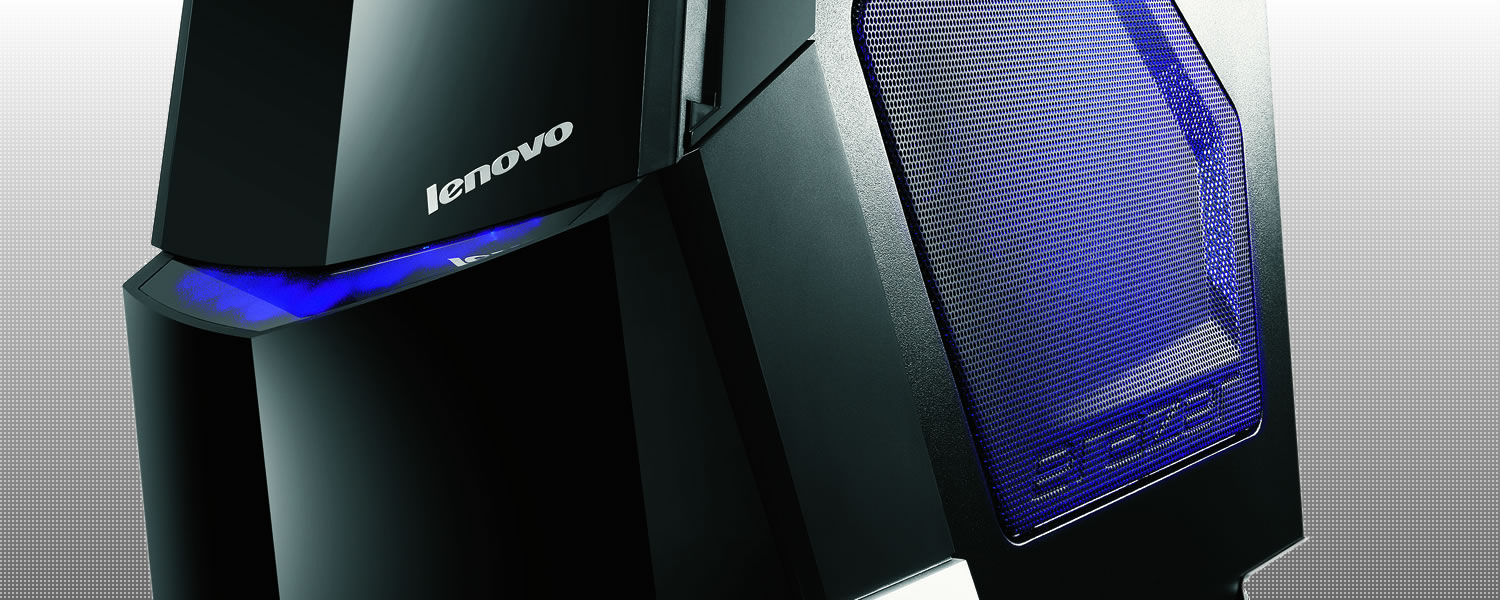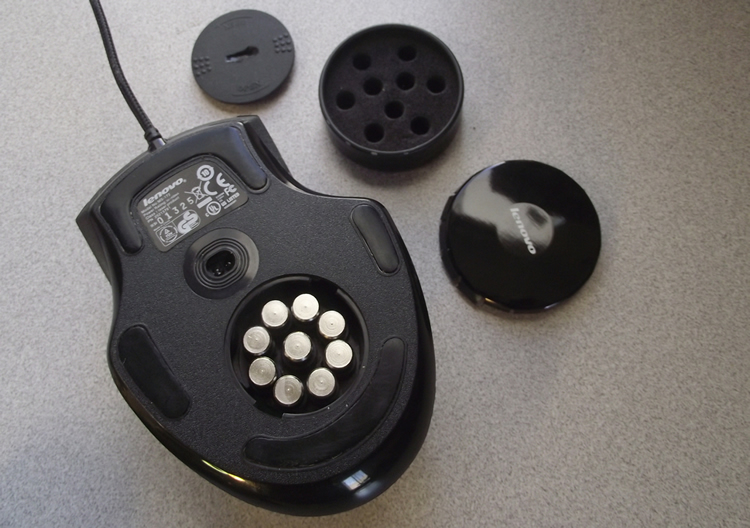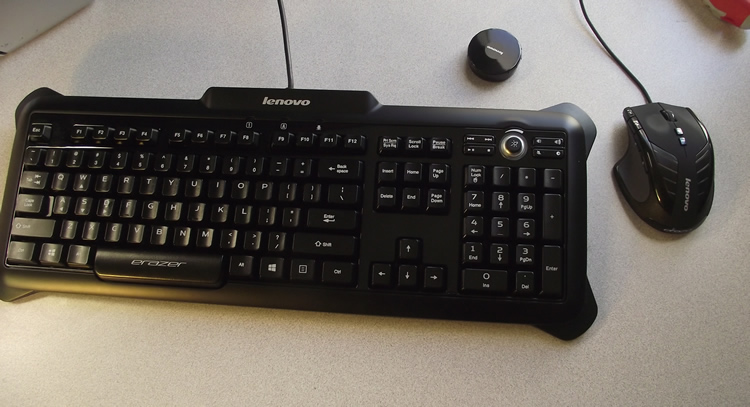Overclocking and Gaming-Oriented Features
Keyboard and Mouse
Lenovo recognizes the close relationship input devices and gaming share, so the X700 ships with a keyboard and mouse that are both several cuts above the ones oft-bundled with mainstream PCs.
The X700's 9-button mouse, the L251G, is both comfortable and extremely customizable. Our review unit didn't actually ship with the full driver suite installed, so I grabbed it from Lenovo's website. With the full software, every aspect of the mouse can be tweaked. Mouse highlights include braided cabling, big low-friction pads, upgradeable firmware, LED color and pulse customization, adjustable DPI, button remapping and weight adjustment. Yep, the L251G includes a weight kit. It seems the L251G is intended for righties; however, it suited my left hand nearly as well.
If you don't mind the absence of dedicated macro keys, Lenovo's back-lit "Black Silk" keyboard is solid for both gaming and typing. It's membrane-based, but mechanical snobs aside, the key travel is good and the key response is firm. Overall, the device is solid with a satisfying size and heft. There aren't many bells and whistles on the Black Silk, but there are some tastefully-inserted media keys on the upper-right above the numpad. For those of you who aren't afraid to look carpal tunnel in the eye, there are also rear feet which can tilt the keyboard to one of two possible heights. Users will be pleased to find a dial which can adjust the brightness (and turn off) of the blue backlight, but won't find the same level of granular configurability here as its mousey companion (e.g. near-infinite backlight colors, LED pulsing or key re-mapping). The keyboard's backlight can be set to one of three colors though: blue, purple or red. There is a dedicated media key that toggles between these colors.
OneKey Overclocking
One of the Erazer X700's primary selling points is its "OneKey" overclocking feature. With OneKey, gamers can toggle processor overclocking by pushing the big "Overclock" button located just above the engin... errr... power button.
The CPU in our review unit had a default multiplier x36. The one-click overclock setting, by default, raised that to x41 which yielded a 500MHz (or about 14%) bump for all CPU cores. For the more adventurous, this can be adjusted up to x43 giving owners a 700MHz (~17% increase). For the record, the system remained 100% stable at x43 (4100MHz). Nice.
While OneKey overclocking is a most welcome feature, it's crippled by a lack of adjustability. The multiplier can be set anywhere up to x43, but that's it – there are no options to manually configure voltages, bus speeds, memory timings or a way to bypass its artificial x43 barrier. Enthusiasts – particularly the gaming kind – will likely find this irritating.
Overclocking on the X700 is actually controlled by the Erazer Control Center, which is a Windows-based utility that provides an elegant read-out for system information like temperatures, part numbers and speeds. The utility does what its supposed to and even looks nice doing it, but doesn't provide any fine-tuning outside multiplier adjustments.
In the search for more overclocking options, I discovered the system BIOS also fails to provide much flexibility. By the way, the system BIOS can be accessed by holding down the F1 key while "starting the engine" (sigh) on your X700. The system does not make this readily apparent though.
One more shortcoming to befall the overclocking button is the need to reboot between multiplier changes. As such, this is a feature which owners are likely set and forget. Even so, having what amounts to a +700MHz turbo button can only be a plus, right? Right.
Note that the overclocking feature doesn't directly enhance GPU performance, which is a shame as the X700's weakest link is its Geforce GTX 660 – a reasonably capable but middling-tier graphics card. Running demanding titles at high resolutions with their highest quality settings illustrates this deficiency: a 17-percent bump in CPU performance often shows less than one-percent difference in FPS.
Cooling and Noise
One possible reason Lenovo has comfortably embraced overclocking is the inclusion of its own maintenance-free liquid cooling system. Conceivably, a liquid cooler offers some extra oomph when it comes to shedding thermal energy quickly and the set up works well on the X700.
For airflow, Lenovo has nestled a 120mm rear exhaust fan (Model: AVC DATA1225B2S, ball-bearing) nestled behind the CPU cooler's radiator block. Additionally, there's a brushless 120mm intake fan up front and a small (40mm) fan mounted atop the CPU's voltage regulator... oh, and a small chipset fan as well.
With FurMark and Prime95 doing their thing for several hours, the X700 proved itself rock solid while overclocked to 4.1GHz. I recorded a max CPU core temp of 73C and a max GPU temp of 62C in an environment with an ambient temperature around 72F.
Subjectively, our Erazer X700 was quiet during most activities. Around 70C though, the fans would become significantly more noticeable albeit far from unbearable. While gaming with an ambient temperature on the cooler side (70F-74F), the X700 never seemed to kick on its max fan speed.
It's important to note that uneven and high-pitched sounds can also be a huge nuisance. The X700's noise output was largely unremarkable except at the top end, where it produces a louder "saw-like" sound which frequently shifted (i.e. draws your attention toward the sound) due to aggressive variable fan control. Just another nit pick.
Power Supply and Consumption
Under a relentless barrage of simultaneous burn-in testing (storage, GPU, CPU and RAM), our Erazer X700's peak power consumption was 340 watts. I should note our review machine survived an overnight torture test (about eight hours), which reflects positively on the PSU.
Our review unit shipped with a 625W power supply from ACBel proudly donning an "80 Plus Gold" certification sticker. This should provide a comfortable margin of headroom for abuse and upgrades.
ACBel may not be a household brand, but they have a solid reputation amongst OEMs for manufacturing reliable PSUs. ACBel is also the OEM for some Cooler Master and Gigabyte PSUs and additionally can be found inside various desktop and server systems from Apple, HP, IBM and Lenovo.
During idle, the system burned around 80-85 watts while light usage and web browsing would bump that near 100w. Gaming and benchmark sessions were all over the place, but 310W was common enough under typical, action-filled gaming sessions.








